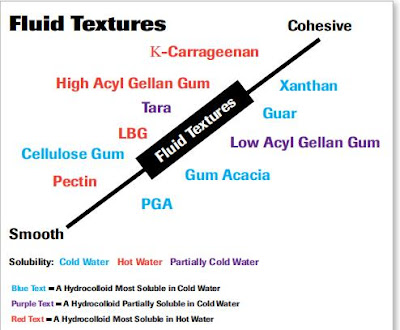Belowing covered topics such as chemical structure, texture, ingredient interactions, stability and processing.
Hydrocolloids are long chains of polysaccharides comprising a backbone and side chains of methoxy or carboxyl groups or sugars.
These functional groups give hydrocolloids interesting properties,
Such as Xanthan gum's side chains of sugars wrap around its backbone—protecting the backbone from acid hydrolysis, making, it extremely acid-stable.
Inversely, locust bean gum (LBG) is a long chain composed of a mannose backbone with a blocky galactose-side chain. LBG's side chains do not protect its backbone from acid hydrolysis, which is a consideration if a longer shelflife (or a lower pH) is desired.
Gelatin is also a hydrocolloid composed of a triple-helix protein structure. It is the folding of the protein that gives gelatin its functionality.
E418 Gellan gum is a multi-functional gelling agent that can produce a wide variety of interesting textures.
CAS:71010-52-1EC:275-117-5HS:39139000
It is extremely effective at low use levels and is available in two forms.
·High Acyl Gellan Gum forms soft,very elastic gels;·Low Acyl Gellan Gum forms firm,brittle gels.
Gellan gum (or E418) is a versatile gelling agent that can produce a wide variety of textures varying from firm, brittle gels that crumble in the mouth, to fluid or elastic gels (depending on conditions & type used). Itcan also be used as a thickening, stabilising and suspending agent. It sets exceptionally fast at ambient temperatures and enables outstanding flavour release.
Plus it is a vegetarian food gum be used as a plant-based alternative instead of gelatin,gellan gum have been approved by USDA for use in organic foods.Non-GMO,vegan friendly,allergen-free and gluten-free.
HYDROCOLLOIDS AND TEXTURE
Viscosity, gelling, suspension and emulsifying are all textural properties associated with hydrocolloids. Some hydrocolloids exhibit different properties under different conditions, particularly when combined.
Xanthan and LBG are two such examples. By themselves, they just add viscosity, but when you blend them together and add heat, they form a gel.
Some hydrocolloids are concentration dependent. Carrageenan, for instance, will form a fluid gel at low concentrations, but at high concentrations, the gel will be more rigid. Other hydrocolloids act as suspension agents and form gels while sitting on a shelf but 'break up nicely and form a light, refreshing beverage'when poured or placed in the mouth, as with carrageenan and high acyl (HA) gellan.
Viscosity may be shear-dependent for certain gums.
Xanthan gum has a high low-shear viscosity, but a higher high-shear viscosity. This means a beverage made with xanthan gum will have a higher viscosity when consumed, which is less refreshing.
INGREDIENT INTERACTIONS AND SENSITIVITIES
A number of ingredient interactions can occur during product formulation—both positive and negative.
A lot of hydrocolloids are ionic in nature and will therefore interact with ions that come from other ingredients, including water. Iota carrageenan, for instance, requires calcium ions for gel setting.
High acyl gellan gum: Colloid solubility is not so sensitive to the metal ions(K+, Na+, Ca2+, Mg 2+, etc).it can be used with monovalent and divalent soluble salt, which are necessary for suspension effect and stability.The optimum sol temperature is above 80℃. pH range is 3.4-7.5. High acyl gellan gum is usually used in non transparent beverage or food, such as dairy products, grain beverage, plant protein drinks, health drinks, meat products, etc. It can also used with CMC, guar, microcrystalline cellulose, pectin, carrageenan to broaden its scope of application.
Low acyl gellan gum: Colloid solubility is more sensitive to the metal ions (K+, Na+, Ca2+, Mg 2+, etc). In other words,the soluble salt can affect the dissolution of gellan gum, but the gel and suspension effect need these ions. Therefore, you'd better add the soluble salts after gellan gum dissolved fully. the optimum sol temperature is above 80℃. The typical application steps are as follows: (1) in the cool deionized water, add gellan gum and stir fully; (2) Heat temperature to above 85℃; (3) add salt (cation); (4) cool the mixture to form a gel or a stable suspension system. Low acyl gellan gum is usually used in transparent suspension drinks, jelly, jams, tissue culture medium plants, air freshener, cosmetics, etc.
Aside from ion sensitivity, hydrocolloids may have a solids requirement or act synergistically or antagonistically with other ingredients.
High methoxy (HM) pectin has a solids requirement of ≥55%, so enough sugar must be used to get full functionality out of the HM pectin in applications such as jams, jellies or fruit fillings.
Carrageenan interacts with protein, forming a synergistic network that's beneficial in milk and plant-based products.
Other examples of synergies include pectin and alginate, which are 'extremely synergistic with one another and form excellent bake-stable fruit fillings'
The combination of gelatin and pectin forms an antagonistic reaction, keeping the gel from becoming too cohesive. Some companies intentionally use these ingredients to produce gummy bears with a less cohesive texture.
'A lot of hydrocolloids are sensitive to acid hydrolysis in their open configuration (hot and in-solution before they set [e.g., carrageenan, gelatin]). Adding acid at the wrong step can be very detrimental to texture,''The opposite can be true where some hydrocolloids don’t care for neutral/basic environments (e.g., pectin, HA gellan). These ionic conditions will modify the finished texture of the gum if they sit in hot and neutral/basic conditions’.
Originally published at https://www.cinogel.com
